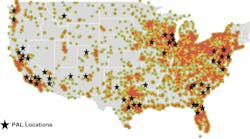WEBBERS FALLS, Okla., May 28 (Reuters) - Rescue workers at a bridge collapse on the Arkansas River recovered six more bodies on Tuesday, bringing the death toll to 13, as a sonar-guided crane helped hunt for cars and trucks submerged in the murky water.
At least 17 vehicles, and perhaps more, were thrown from the bridge when two connected barges guided by a tug struck the span, collapsing a 500-foot (150-metre) section, on a major east-west thoroughfare on Sunday.
The vehicles dropped about 100 feet (30 metres) and slammed into each other, forming a mangled pile of metal in the rain-swollen river.
Ten vehicles have already been recovered and sonar mapping of the river bed indicates another seven are probably still submerged in about 11 feet (3.5 metres) of swiftly moving water.
The final death toll is expected to be at least 17, officials said, adding it could be higher if more vehicles were lying undetected under massive slabs of the collapsed bridge. Four people survived.
National Transportation Safety Board investigator George Black told NBC's "Today" program the captain of the tug, Joe Dedmon, 61, suffered "some incapacitation" before the accident.
A spokesman for the owners of the barges have previously said they believed Dedmon suffered a blackout. Initial drug and alcohol tests on Dedmon, who has 30 years experience piloting river boats, were negative, police said.
Black said the NTSB had interviewed Dedmon and five crew members of the tugboat which was guiding the two 500-foot (150 metre) barges. The crew gave information that would confirm some incapacitation of Dedmon, Black said.
"They indicated that the collision alarm and the collision whistle did not occur until after the impact, which would indicate some sort of incapacitation on the part of the captain," Black said.
"A deck hand visited with the captain in the pilot house he said five to 10 minutes before the collision. He noted nothing unusual at that time. He also indicated that the I-40 bridge was in sight when he left the pilot house," he said.
IDENTIFYING VICTIMS
The crash cut traffic on Interstate 40. The bridge is typically used by about 20,000 vehicles a day and the interstate is one of the main transport links between the East and West Coasts.
Rescue workers battled slippery conditions on recovery barges, while police divers felt for vehicles among shards of submerged, jagged metal, in poor water visibility at the accident site about 60 miles (95 km) south of Tulsa.
The Oklahoma Highway Patrol said the bodies of three men and three women were found on Tuesday, taking the total number of known dead to six men and seven women. The first identified victim of the bridge collapse was Andrew Clements, 35, a U.S. Army serviceman who was driving from California to Virginia, police said.
Also dead were two race and rodeo horse trainers Gail Shanahan, 49, and Maggie Green of Texas. The two were returning from racing horses at an Arkansas track over the weekend and they died along with at least three horses they were transporting back to Texas, police said.
Norman, Oklahoma police detective Wayne Martin and his wife, Susan were also among the dead. Martin was influential in starting the state's police divers program and the couple was heading to a family reunion in Arkansas, police said.
An Army Corps of Engineers official said the crash probably did not block the navigation channel.
River traffic will likely resume after recovery operations are completed, the stability of the still-standing portion of the nearly 2,000 foot (610 metre) bridge is assured and tests show the navigation channel is free of impediments, he said.
Vehicles are being taken about 50 miles (80 km) out of their way to avoid the bridge, the highway patrol said.
A highway engineer at the site said it would likely take six months to repair the span.


